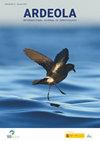仓燕在西班牙西南部繁殖和在西非越冬的迁徙系统
IF 1.2
4区 生物学
Q2 ORNITHOLOGY
引用次数: 4
摘要
总结。许多候鸟种类的数量正在迅速减少。作为开展有效保护工作的必要条件,必须全年确定移徙者的下落。然而,我们对大多数物种的迁徙路线和跨年周期的时空发生的了解仍然有限。我们使用轻型地理定位器详细描述了仓燕在西班牙西南部繁殖和在西非越冬的迁徙系统。利用FLightRR软件包成功检索了38只个体的全年数据,并重建了它们的迁徙路线。许多被研究的个体在夏天停留了一段时间,在西班牙南部和摩洛哥北部徘徊,我们将这段时间定义为预迁移。被研究的燕子平均于8月18日开始秋季迁徙,在摩洛哥西北部和马里南部停留加油。平均而言,被标记的个体在9月3日到达它们的越冬区,这些越冬区分布在象牙海岸及其周边国家,主要是热带草原、草原和农作物。越冬后,燕子平均于1月26日开始春季迁徙,中途停留在塞内加尔和毛里塔尼亚。它们平均在2月18日(从1月中旬到3月中旬)回到西班牙的繁殖地。令人惊讶的是,在秋季迁徙期间,其中一只被标记的个体在返回南方之前前往英格兰,并在西班牙西北部度过了短暂的冬季。-López-Calderón, C, Magallanes, S., Marzal, A. & Balbontín, J.(2021)。谷仓燕的迁徙系统在西班牙西南部繁殖,在西非越冬。中国生物医学工程学报,68:335-354。本文章由计算机程序翻译,如有差异,请以英文原文为准。
The Migration System of Barn Swallows Hirundo rustica Breeding in Southwestern Spain and Wintering Across West Africa
Summary. Many populations of migratory bird species are rapidly declining. As a requisite for targeting effective conservation efforts it is essential to determine the whereabouts of migrants year-round. However, our knowledge of migratory routes and spatial-temporal occurrence across periods of the annual cycle is still limited for most species. We used light-level geolocators to describe in detail the migration system of Barn Swallows Hirundo rustica breeding in southwestern Spain and wintering across West Africa. We were able to successfully retrieve year-round data for 38 individuals and reconstructed their migratory routes using FLightRR package. Many of the studied individuals remained for some time in summer wandering through southern Spain and northern Morocco, a period that we defined as pre-migration. The studied swallows started their autumn migration on average on August 18th, stopping over to refuel in northwestern Morocco and southern Mali. On average the tagged individuals arrived on September 3rd at their wintering areas, which were located across Ivory Coast and surrounding countries, in localities dominated by savannahs, grasslands and crops. After wintering, swallows started the spring migration January 26th on average, stopping over in Senegal and Mauritania. They arrived back at the Spanish breeding colonies February 18th on average (from mid-January to mid-March). Surprisingly, during the autumn migration, one of the tagged individuals travelled to England before returning south and spending a short wintering period in northwestern Spain.—López-Calderón, C., Magallanes, S., Marzal, A. & Balbontín, J. (2021). The migration system of Barn Swallows Hirundo rustica breeding in southwestern Spain and wintering across west Africa. Ardeola, 68: 335-354.
求助全文
通过发布文献求助,成功后即可免费获取论文全文。
去求助
来源期刊
CiteScore
2.30
自引率
6.20%
发文量
16
审稿时长
>12 weeks
期刊介绍:
Ardeola: International Journal of Ornithology is the scientific journal of SEO/BirdLife, the Spanish Ornithological Society. The journal had a regional focus when it was first published, in 1954. Since then, and particular during the past two decades, the journal has expanded its thematic and geographical scope. It is now a fully international forum for research on all aspects of ornithology. We thus welcome studies within the fields of basic biology, ecology, behaviour, conservation and biogeography, especially those arising from hypothesis-based research. Although we have a long publication history of Mediterranean and Neotropical studies, we accept papers on investigations worldwide.
Each volume of Ardeola has two parts, published annually in January and July. The main body of each issue comprises full-length original articles (Papersand Review articles) and shorter notes on methodology or stimulating findings (Short Communications). The publication language is English, with summaries, figure legends and table captions also in Spanish. Ardeolaalso publishes critical Book Reviewsand PhD-Dissertation Summaries; summarising ornithological theses defended in Spain. Finally there are two Spanish-language sections, Ornithological News; summarising significant recent observations of birds in Spain, and Observations of Rare Birds in Spain, the annual reports of the Spanish Rarities Committee.

 求助内容:
求助内容: 应助结果提醒方式:
应助结果提醒方式:


